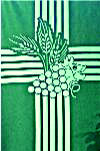|
Click here to
 |
Ordinary Time
Counted Time of the Church Year
Dennis Bratcher
Most of the Seasons of the Christian Church Year
are organized around the two major festivals that mark sacred time,
Christmas and Easter. The
Christmas Season encompasses the time of preparation during
Advent
and the celebration of the Twelve Days of Christmas
and Epiphany in early January (the 6th). The
Easter Season encompasses the time of
preparation during the 40 weekdays of Lent and
Holy Week, and is linked with Pentecost
Sunday 50 days later. While there are other individual holy days within
the church year, these seasons mark the movement of sacred time within the
church calendar.
The rest of the year following Epiphany and Pentecost is known as
Ordinary Time. Rather than meaning "common" or "mundane," this
term comes from the word "ordinal," which simply means
counted time (First Sunday after Epiphany or Pentecost, etc.), which is
probably a better way to think of this time of the year. Counted time
after Pentecost always begins with Trinity Sunday (the first Sunday after
Pentecost) and ends with Christ the King Sunday or the Reign of Christ the
King (last Sunday before the beginning of Advent).
Many Protestant church traditions consider the Sundays following Epiphany
a season
of Epiphany that runs until the beginning of Lent. Those traditions that
follow the Roman Catholic calendar only count January 6th as Epiphany and do
not think of a season of Epiphany, so consider the Sundays following part of
Ordinary Time. In either case, the Sundays after Epiphany are counted
(1st Sunday after Epiphany, etc.) so technically are Ordinary Time. However
in most Protestant churches Ordinary Time usually refers to the Sundays
after Pentecost Sunday and before the beginning of Advent.
The 33 or 34 Sundays of Ordinary Time after Pentecost (23 to 28 Sundays after Pentecost)
are used to focus on various aspects of the Faith, especially the mission of
the church in the world. The Lectionary readings
for these Sundays tend to be semi-continuous readings through certain
sections of Scripture, especially through the Synoptic Gospel of the year.
However, many ministers use Ordinary Time to focus on specific themes of
interest or importance to a local congregation rather than building sermons
around the Lectionary readings. Even so, most pastors who observe the church
year will continue to follow the Lectionary readings in public worship even
if they are not the topic of the sermon in order to preserve the continuity
of the spoken word of Scripture being heard by the congregation (see
Word and Table).
The sanctuary color for Ordinary Time is dark green, although other
shades of green are commonly used. Green has traditionally been associated
with new life and growth. Even in Hebrew in the Old Testament, the same word
for the color "green" also means "young." In Christian tradition,
green came to symbolize the life of the church following Pentecost, as well
as symbolizing the hope of new life in the resurrection.
However, many churches
introduce variety into the color scheme during this part of the year. Some
churches use colors that match the décor of the church, so that the special
seasons of the church year are marked by a change of color from the
ordinary. Some churches coordinate parament colors with sanctuary banners
that present various biblical themes during this part of the year. The most
often used alternate colors for Ordinary Time are bronze or copper, olive,
and aqua with maroon showing up occasionally.
Some church traditions only celebrate Pentecost
Sunday
and Trinity Sunday (the first Sunday
after Pentecost), and then begin Ordinary Time with the Second Sunday after
Pentecost that runs until Christ the King
Sunday,
the last Sunday before the beginning of Advent. Other traditions observe a
Pentecost Season extending for the eleven to sixteen Sundays (depending
on the date of Easter) beginning with Pentecost Sunday and running through
the next to last Sunday of August. Then beginning with the last Sunday of
August, they count the remaining thirteen or fourteen Sundays until the
beginning of Advent as Kingdomtide
(in the Methodist tradition) or Dominiontide
(in other churches), climaxing with the Christ the King Sunday.
This serves to break up the long stretch of Ordinary Time following
Pentecost into two seasons that can carry different emphases.
The season of Pentecost usually focuses on the evangelical mission of
the church to the world and its responsibility in carrying out that mission
of proclamation. That emphasis often extends into Ordinary Time. Some Protestant churches also celebrate
Reformation Sunday (end of October)
and All Saints Sunday (first Sunday in
November). These are becoming increasingly popular ways to flesh out the
themes of the Church in the World during Ordinary Time by focusing on
heritage and the faithfulness of those in the past. The season of Kingdomtide celebrates Christ as King
and Sovereign of the world, emphasizing God's Dominion over all of creation.
The focus in this season is often on social justice and action as an
expression of the Lordship of God over his people and the world.
-Dennis Bratcher, Copyright ©
2021, Dennis
Bratcher, All Rights Reserved
See Copyright and User Information Notice |

Related pages
Church Year
Colors of the Church Year
Daily Scripture Readings
Lectionary
Lectionary Commentary:
Year A
Year B
Year C
Services of Worship:
Reformation Sunday
All Saints Sunday
Christ the King Sunday
|

